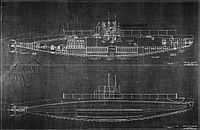USS F-4 (SS-23)
.jpg) USS F-4 sometime between 1913 and 1915. | |
| Career | |
|---|---|
| Name: | USS F-4 |
| Builder: | Moran Brothers Company, Seattle, Washington |
| Laid down: | 21 August 1909, as USS Skate |
| Launched: | 6 January 1912 |
| Commissioned: | 3 May 1913 |
| Renamed: | USS F-4, 17 November 1911 |
| Struck: | 31 August 1915 |
| Fate: |
Foundered, 25 March 1915 Raised, 29 August 1915; later a harbor marker and buried as trench fill off Pearl Harbor, 1940 |
| General characteristics | |
| Class and type: | F-class submarine |
| Displacement: | 330 long tons (340 t) |
| Length: | 142 ft 7 in (43.46 m) |
| Beam: | 15 ft 5 in (4.70 m) |
| Draft: | 12 ft 2 in (3.71 m) |
| Speed: | 14 kn (16 mph; 26 km/h) |
| Complement: | 22 officers and enlisted |
| Armament: | 4 × 18 in (460 mm) torpedo tubes |
USS F-4 (SS-23) was a F-class submarine. Her keel was laid down by the Moran Brothers of Seattle, Washington. She was originally named Skate, making her the first ship of the United States Navy named for the skate. She was renamed F-4 on 17 November 1911. She was launched on 6 January 1912 sponsored by Mrs. M.F. Backus; and commissioned on 3 May 1913 with Lieutenant (junior grade) K.H. Donavin in command.
Service history
Joining the First Submarine Group, Pacific Torpedo Flotilla, F-4 participated in the development operations of that group along the west coast, and from August 1914, in Hawaiian waters. During submarine maneuvers off Honolulu, Hawaii on 25 March 1915, she sank at a depth of 306 ft (93 m), 1.5 mi (2.4 km) from the harbor. Despite valorous efforts of naval authorities at Honolulu to locate the missing boat and save her crew, all 21 perished (C.O. LT(jg) Alfred Louis Ede and crew). F-4 was the first commissioned submarine of the U.S. Navy to be lost at sea.

A diving and engineering precedent was established with the Navy's raising of the submarine on 29 August 1915. Courage and tenacity marked the efforts of divers who descended to attach cables to tow the boat into shallow water, while ingenuity and engineering skill characterized the direction of Naval Constructor J.A. Furer, Rear Admiral C.B.T. Moore, and Lieutenant C. Smith who accomplished the feat with the aid of specially devised and constructed pontoons. Navy diver George D Stillson found the superstructure caved in and the hull filled with water.[1] Only four of the dead could be identified; the 17 others were buried in Arlington National Cemetery.[2]
The investigating board subsequently conjectured that corrosion of the lead lining of the battery tank had permitted seepage of sea water into the battery compartment and thereby caused the commanding officer to lose control on a submerged run. Others believe that the bypassing of an unreliable magnetic reducer closed a Kingston valve in the forward ballast tank resulting in a delay.[3] Based on other reported issues, there may also have been problems with the air lines supplying the ballast tank.[3]
F-4 was stricken from the Naval Vessel Register on 31 August 1915.
In 1940, the remains of F-4 were buried as fill in a trench off the Submarine Base, Pearl Harbor.


References
- ↑ staff. "WATER IN HULL OF F-4.; Diver Also Reports That Superstructure of Submarine Has Caved In.". NY Times. Retrieved 2011-08-24.
- ↑ Honolulu Star-Bulletin (2000). "The United States Submarine F-4 March 25, 1915". Arlington National Cemetery. Retrieved 2009-04-15.
- ↑ 3.0 3.1 Searle Jr, Willard F; Curtis Jr, Thomas G (2006). "The loss and salvage of F-4, a historic milestone". Undersea Warfare (Navy) 7 (6). Retrieved 2009-04-15.
This article incorporates text from the public domain Dictionary of American Naval Fighting Ships. The entry can be found here.
| Wikimedia Commons has media related to USS F-4 (SS-23). |
External links
- Photo gallery of USS F-4 at NavSource Naval History
- On Eternal Patrol: USS F-4
- The United States Submarine F-4 at arlingtoncemtery.net
| ||||||||||